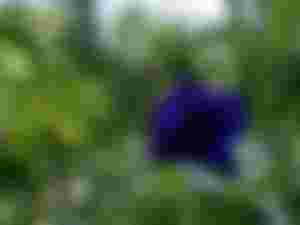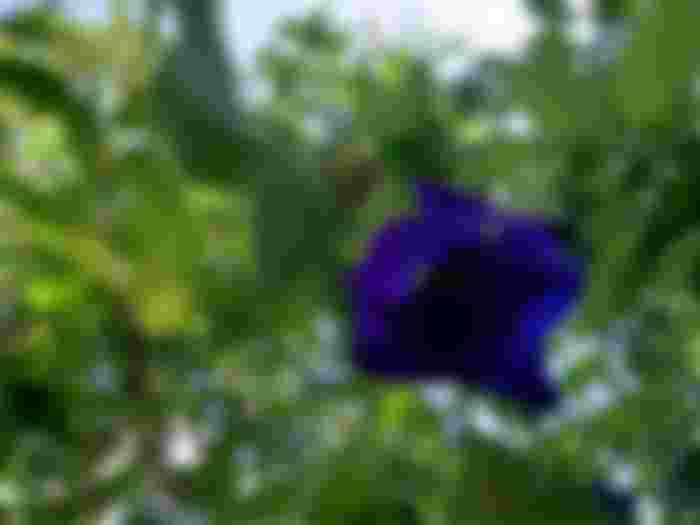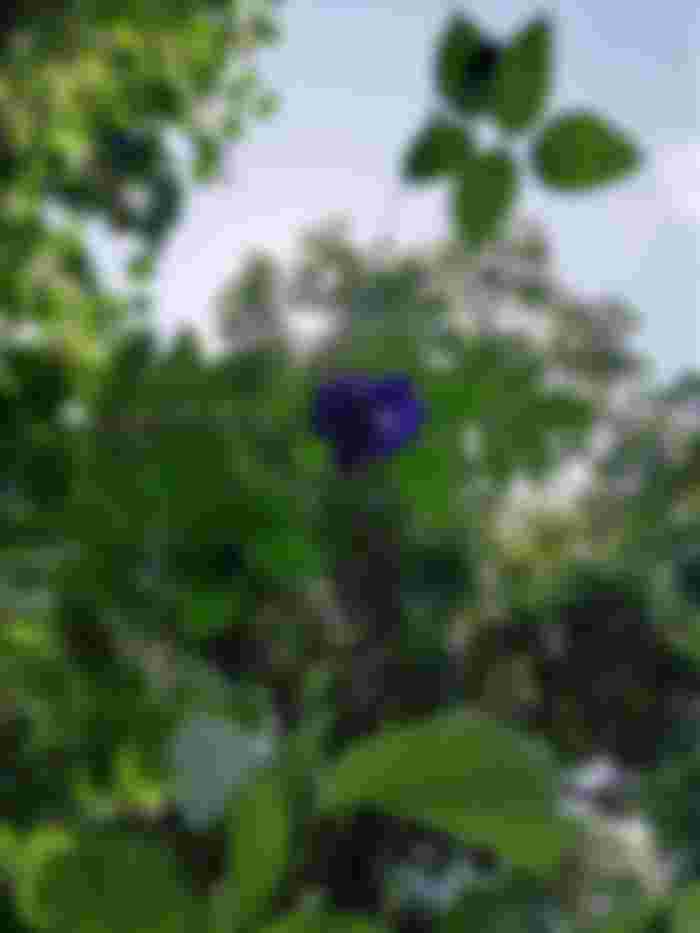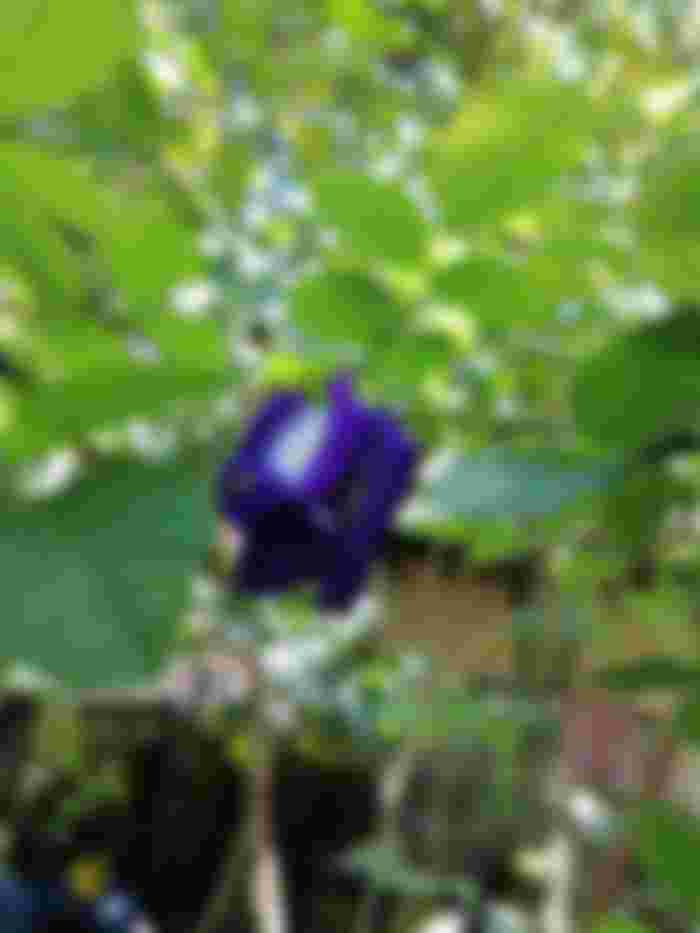It's been a while since I shared some of our planted plants at home. It rained the whole week due to tropical storms. I love taking pictures, especially of nature. Since photography is one of my hobbies, I love to make some articles about my photography too.
Our garden now was full of plants, people already called me “plant momma”, because I'm too young to be called tita or “plant tita” 😅. I love planting and collecting flowers and some shrubs. And of course, I've introduced here some of it, and most especially our medicinal plants such as Mayana and Oregano.
But before the flowers and some shrubs have planted, there was a lovely vine that bears lovely flowers. The flower was beautiful in blueish-purple color. And If you'll have a walk-in our garden, this plant will surely catch your attention.
I'm referring to our planted Asian Pigeonwings or Blue Ternate.

*Honestly, I shared here our blue ternate before as a photography article.
Asian Pigeonwings
Scientifically it is called Clitoria ternatea and commonly known as ‘blue pea’ or blue ternate. It is a perennial twinning herbaceous plant which belongs to the family Fabaceae. It has two main varieties based on the color of the petals, the white, and the blue-flowered varieties. And what we have at home was a blue-flowered variety.
Amazing Facts About Blue Ternate

Did you know that the Blue Ternate has multiple uses?
Its uses include the following:
In terms of food, the most used part of food is the flower.
Have you seen blue rice? Yes! it's color blue.

Here in my province we usually make blue rice out of blue ternate's flowers.
In Southeast Asia and Malaysia, the flowers are used to color food. In Thailand, they use the flowers to make a syrup blue drink called “Nam dok anchan” and this drink is sometimes consumed with a drop of sweet lime juice to enhance acidity and turn the juice into pink-purple color. In Burmese and Thai cuisines, the flowers are also dipped in batter and fried.
In the field of medicine, it is ascribed numerous qualities including, memory enhancing, antistress, anxiolytic, antidepressant, anticonvulsant, tranquilizing, and sedative properties in the traditional Hindu system of medicine. In traditional Chinese medicine, due to its image and appearance, similar to the female reproductive organ, which gained its name of Clitoria ternatea, it was used traditionally in an attempt to treat sexual disorders, such as infertility and gonorrhea, to control menstrual discharge, and also as an aphrodisiac.
In Horticulture, it is grown as an ornamental plant, oriented on an arbor or chain link fence. It also looks beautiful in a hanging basket. It is used as a revegetation species (e.g., in coal mines in Australia), requiring little maintenance when cultivated. It can be grown with elephant grass (Pennisetum purpureum ), and forage sorghums (Sorghum bicolor), and millets as well as Panicum maximum. Also sown with pergola (Digitaria eriantha ) as a pasture, and Andropogon gayanus and Dichanthium aristatum.
It is also used in nitrogen fixation. This plant is used to improve soil quality and disposition through the decomposition of nitrogen-rich plant material.
How to grow Blue Ternate

You can propagate by seed or cuttings. Pluck the seeds and soak overnight in room temperature water before planting. Sow directly in the garden with 3–4-inch spacing. Seeds will germinate in 1-2 weeks. Cuttings root easily in moist sand or vermiculite.
What's nice about this plant is that it can adapt to a wide range of soil types from sandy soils to heavy clays including calcareous soils.
Health Benefits and other Medicinal Uses of Blue Ternate
This plant doesn't only provides beauty in your garden, but comes along with its beautiful flowers are packs of health benefits which are surprisingly beneficial in your overall health.
Boosts brain health. Butterfly pea consists of Acetylcholine, and its consumption helps to boost the levels of Acetylcholine in the brain. Acetylcholine decreases with progress in age causing loss of memory and other problems. Consumption of butterfly pea can reverse this process and improve thinking abilities.
It is also the solution to the irregular period in women. Clitoria ternatea is helping Asian women in dealing with their irregular period issues. Furthermore, this beautiful flower is also able to help to deal with some reproductive issues in women.
Improves nervous system. The plant consists of some compounds that are great to improve the function of the nerve system. In other words, this flower is also great for the brain.
For Fertility. The herb is effective in treating female sexual disorders like infertility, correct menstrual disorders, etc. Also, the flowers serve as a sexual enhancer or aphrodisiac.
Stress Reliever. The roots of Clitoria ternatea are used to treat mental disorders. They also relieve stress and hence are sold as antidepressants.
Good for Circulatory System. The herb has the property to regulate the circulatory system. It purifies the blood in the body and gives new energy to the body.
For treating Cough, Cold, and Asthma. The roots of Clitoria ternatea have great medicinal value. They can be powdered and consumed. They instantly cure whooping cough. The herb also cures cold and asthma present in people. The plant can be used to smoke to cure throat-related infections. A decoction can be prepared and used to gargle to cure core throats.
Blue Tea

Here's the most well-known healthy drink made from Blue Ternate, the “Blue Tea”. This tea is very healthy and caffeine-free. Blue Tea is made by seeping dried butterfly-pea flowers in water and can be enjoyed both hot and cold.
HOW TO MAKE BLUE TEA
Ingredients
16 ounce of drinking water
10 raw flowers from the Clitoria ternatea plant
3 drops lemon juice
Instructions
Soak freshly plucked flowers from the Clitoria ternatea plant in a bowl or cup overnight. Makes around 1 cup of soaked flowers.
Pour out soaking water and place petals in a teapot. Steep with warm or hot water for three minutes.
Add drops of fresh lemon juice and observe the tea turning bluish purple.
*Recipe from www.happycow.net
Benefits of Blue Tea 🍵
This natural detox drink has a lot of health benefits. And one of the most known benefits of it is it can help you in losing weight. Apart from weight loss, Blue Tea is a good source of Polyphenols and has been proven to prevent Type I diabetes by controlling glucose metabolism in our body. It is also improving hepatic metabolism, which means it helps in preventing and treating fatty liver issues. It also burns cholesterol, clears arteries, improves blood circulation, and reduces your vulnerability to cardiovascular diseases. Blue Tea is known for its anti-aging properties which are due to the high concentration of antioxidants present in its leaves. Also, it has been clinically proven to contain a much higher amount of antioxidants as compared to Green Tea.

You can grow your own blue ternate at home. There's a lot of seeds being sold online and in the markets. Or if your neighbor has, you can be asked for some seeds or stem cuttings to plant. Now our blue ternate only got few flowers, it is believed that this plant blooms continuously from summer through fall.
I can say that this plant, Blue Ternate is one of the most incredible creations our nature can provide. From its unique beauty, up to its various useful benefits to our health.
@eommaZel ✍🏻
Featuring our Own Planted
Blue Ternate 🥀Sources:
http://pza.sanbi.org/clitoria-ternatea-var-ternatea








I have that flower at home but I don't remember what they call it here, they gave it to my mother, It is very beautiful. I've never tasted tea, I'll have to do the test.